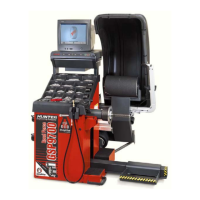GSP9700 Series Road Force Measurement System Operation 4. Balancing a Wheel 65
Lateral/Radial Rim High Spot Indicators Feature
The “Show Lateral High Spot(s)” and “Show Radial High Spot(s)” softkeys are available
to select a graphic depiction of the exact radial (blue indicators) or lateral (orange
indicators) first harmonic runout high spot locations. The high spots indicated are the
high spots of the first harmonic, NOT the T.I.R. runout high spots. The lateral/radial high
spots correspond to the lateral and radial first harmonic rim runout amounts on the left
side of “Current Runout & Road Force” screen. Located 180 degrees from the rim
matching mark is a green indicator that will appear between the rim lips to identify the
rim average 1st harmonic high spot.
Details/Diagnosis Explanation Key
“Show Details” can be selected to view detailed data about measurements taken and
the limits for each measurement.
When limits that are not first harmonic are exceeded, the “Show Details” key will be
replaced with an “Explain Diagnosis” key which can be selected to view information on
exceeded limits for the rim or tire. Refer to “Diagnosis Explanation Screen,” page 95.
Encountering ForceMatching™ Prediction Errors
Below are some reasons why the GSP9700 may not match or quantify the value of
the tire or the assembly.
Incorrect Mechanical Wheel Mounting on the Shaft:
This can be caused from worn or damaged adaptors, rust, or debris on the
wheel, shaft, hub, adaptors, or a cone contacting a wheel on an irregular surface.
Verify proper mounting by performing a centering check.
External Rim Measurement vs. Actual Bead Seat Measurement:
There is a high correlation between external and internal measurement, however
the operator must consider each wheel design individually. Some cast or closed-
faced wheels cannot be accurately measured externally. The tire must be
removed for accurate bead seat runout measurements.
Air Pressure Readings Before and After Matching Differ:
The air pressure should remain constant between each measurement. Always
inflate tires to the recommended pressure specified by the vehicle manufacturer.
Incorrect Tire Bead Seating Procedures:
Tire technology is always changing. Today’s vehicles require the tire to be
designed to tightly adhere to the wheel, preventing slippage between the two
components. As a result, incorrect tire bead seating procedures are becoming
more of an issue in solving vibration complaints. In many cases, a wheel will
display high non-uniformity values because of increased tire bead interference,
wheel design, or improper bead seating procedures. If the tire is re-loosened
from the wheel and properly lubricated and remounted, the level of non-
uniformity may decrease dramatically. On sensitive vehicles, sometimes there is
benefit to slightly over-inflating the tire, deflating the air, and then re-inflating to
optimize bead seating.
Insufficient Use of Tire Mounting Lube During Mounting:
“Lube is Good!” Proper lubrication on the tire bead and rim areas including bead
seat, hump, balcony, and drop center are vital in achieving proper seating of the
tire bead to the wheel assembly. Aggressive acceleration or braking should be
avoided for the first 500 miles to prevent tire to wheel slippage.
Rim Safety Hump Design ‘Hangs Up’ Tire Bead During Bead Seating:
Some types of wheels use a square safety hump that may further inhibit uniform
tire bead seating. This further underscores the importance of proper lubrication
and bead seating procedures.
Temporary Flat Spotting:
Flat spotting may occur when the tire is in one position for an extended period of
time, such as a parked vehicle, improper storage of the tire, and temperature
extremes. Measurements for force and balance will stabilize as soon as the tire
is driven for a few miles. This important issue can also affect traditional wheel
balancing procedures.
Excessive Lateral Runout of Tire and/or Rim:
A tire or wheel with high lateral readings may affect the predicted results of radial
force after ForceMatching.

